PhotoReview #2 | London Architecture by Rimicane | Architecture Londonienne par Rimicane
Rimicane Submission
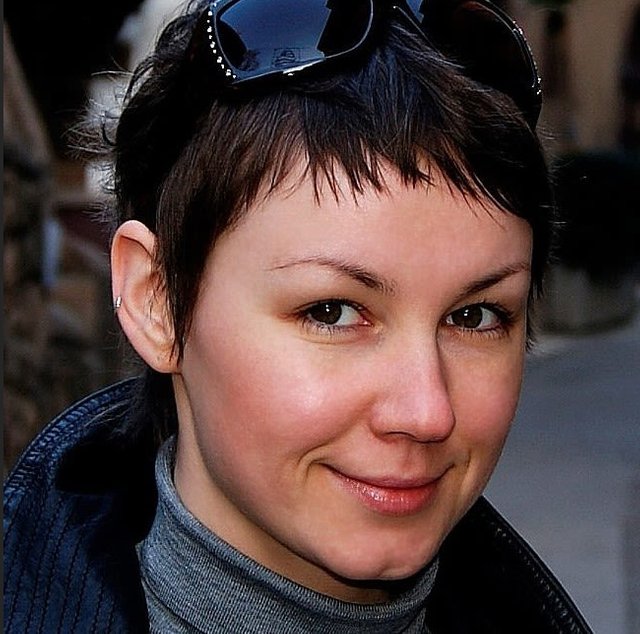
[EN] : Today, @rimicane from Russia and living in London submits a colored architecture photo. New with DSLr, and early photo beginner, Nicolas and Vincent are going to review it. But let's first discover her picture as initialy posted.
[FR] : Aujourd'hui, @rimicane, d'origine russe et vivant à Londres, nous soumet une photo d'architecture très colorée. Débutante avec son numérique, Nicolas et Vincent vont en faire une analyse. Mais commençons par découvrir son image!
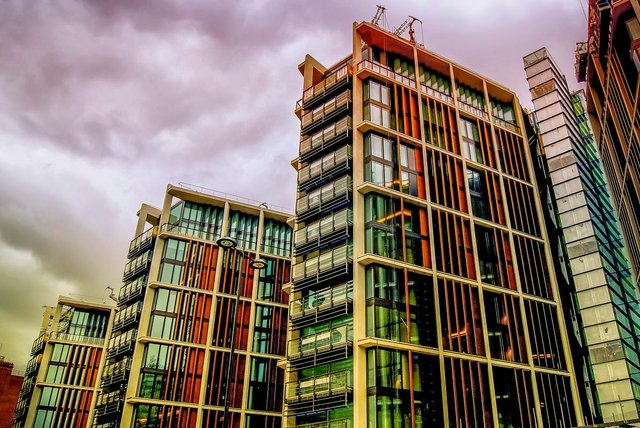
"Modern architecture can be as interesting and exciting as the classic in any shape or form. Here is an example of the modern British architecture right in the middle of London. I have played with the gradient tool to add a bit of drama to the building"
Vincent's Review / La revue de Vincent
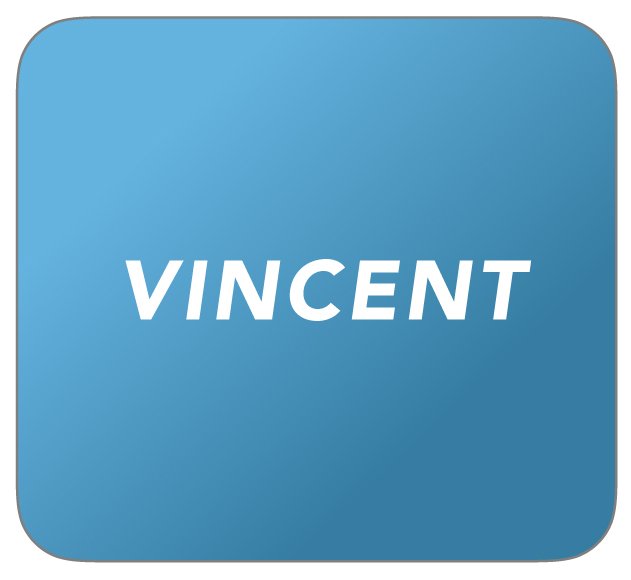
[EN] : Well, Architecture photos are not really my cup of tea to be honest. Mostly because these kind of photos have no real story and remains strictly graphical. But anyway, as soon as I have seen your picture, I knew I could tell you a lot and by consequence brings to our followers many indications too! Secondly, to have discussed with you since a few days, you are willing to improve your photo skill and you will be the proof that we can review all level. Let's go!
[FR] : Alors pour être très honnête, les photos d'architecture... ce n'est pas ma tasse de thé. Bien souvent ce type d'image est strictement graphique et ne me parle pas et ne raconte aucune histoire. Mais bon, en voyant ton image, je me suis dit qu'il y avait tellement de choses à dire que cela valait le coup pour toi comme pour tous nos followers d'avoir une réflexion sur ce type d'image. Deuxièmement, pour avoir discuté depuis quelques jours avec toi, j'ai senti cette volonté d'apprendre et de t'améliorer et tu seras la preuve que tous les niveaux sont les bienvenus dans PhotoReview. Allons y!
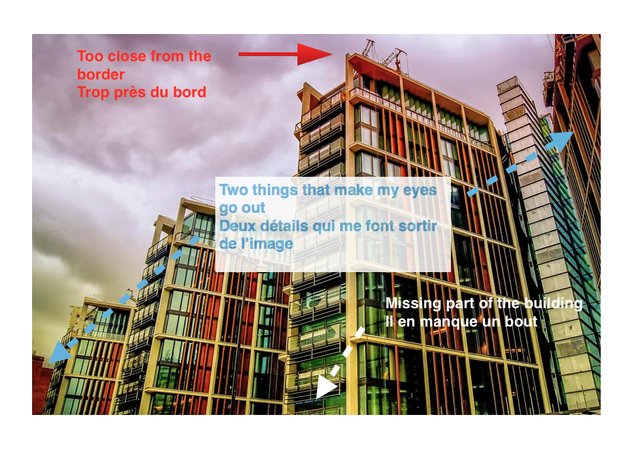
[EN] : First point : the composition. With this kind of pictures, you have two options : wide angle and have more sky and more depth, although you go closer with more details. In your case, you are just in between. See my scheme. the top of your building is too close from the border and I can not have a full perspective. Also, two details, one on the left part and one on the right part that makes my eyes go out! As soon as my eyes go out, I go to another picture and you miss your point.
[FR] : Premier point : la composition. sur ce genre d'image, soit c'est un plan large avec de la profondeur et un ciel qui m'emmène en haut, soit on se rapproche et va dans le détail. Toi, tu n'as choisi ni l'un ni l'autre et on est juste au milieu des deux approches. (voir mon schéma). Le haut de ton immeuble est beaucoup trop proche du bord et m'empêche d'avoir une vraie perspective. A cela, deux détails, un à droite et un à gauche qui attirent mon oeil et me font sortir de l'image. Conséquence, je passe à une autre image et tu es passée à côté de ton objectif.
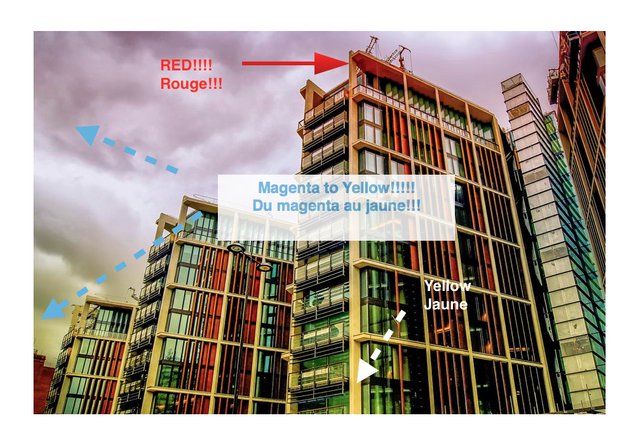
[EN] : Second point : the colorimetry. You admit to have used a gradient filter in photoshop and obviously, I can not miss it. Have you ever seen such a sky in the real life? Of course not. As such, your filter is the only thing I see. But let's go further. In this image, the buildings have red color, green and some blue. With your filter you add magenta and yellow! That is too much and "destroyes" the building colors. To remember : respect the primary colors and also always use the filters slightly, with a view it must not be detected by your spectators. It is often a drawback with beginners that push the cursors too much.
[FR] : Deuxième point: la colorimétrie. Tu admets avoir utilisé un filtre de couleur de type gradient dans photoshop, et pour le coup, impossible de ne pas le voir! As-tu déjà vu un tel ciel dans la vie réelle? Bien sûr que non. Et objectivement, je ne vois plus que ça. Allons un peu plus loin : les bâtiments contiennent du rouge, du vert et du bleu. En appliquant ton filtre, tu rajoutes du jaune et du magenta, et là c'est too much! Tu diminues l'impact des couleurs du bâtiment. Apprends à jouer avec les couleurs primaires qui se répondent bien et surtout utilise les filtres avec plus de finesse, on ne doit pas voir que tu as utilisé un filtre. C'est d'ailleurs souvent le défaut des débutants qui poussent les curseurs au maximum.
[FR] : ci-dessous, deux propositions. La première pour revenir à la réalité et corriger toute ta balance colorimétrique. si cela t'as pris dix secondes pour mettre ton filtre, il m'a fallu plus d'une heure pour l'enlever avec au moins trente opérations dans Photoshop. La seconde proposition va respecter ce que tu voulais avoir: une ambiance dramatique et pour cela, je vais renforcer le ciel qui a de la matière en appliquant un filtre "tonal contrast" en mode produit mais en douceur. Alors maintenant question: tu préfères ta version ou la mienne?
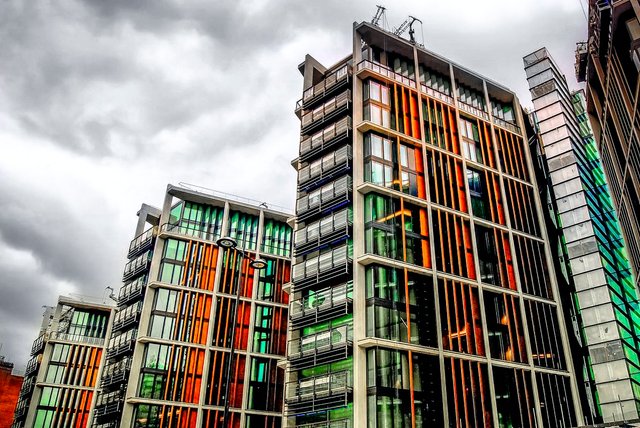

[FR] : Conclusion : tu débutes alors n'abandonne pas! Recommence et recommence encore. Je crois sincèrement que tu as tout le potentiel et la volonté pour aller au bout de ta passion photographique. Merci pour ta participation et j'espère que cette revue t'aidera au maximum.
Nicolas' Review / La revue de Nicolas
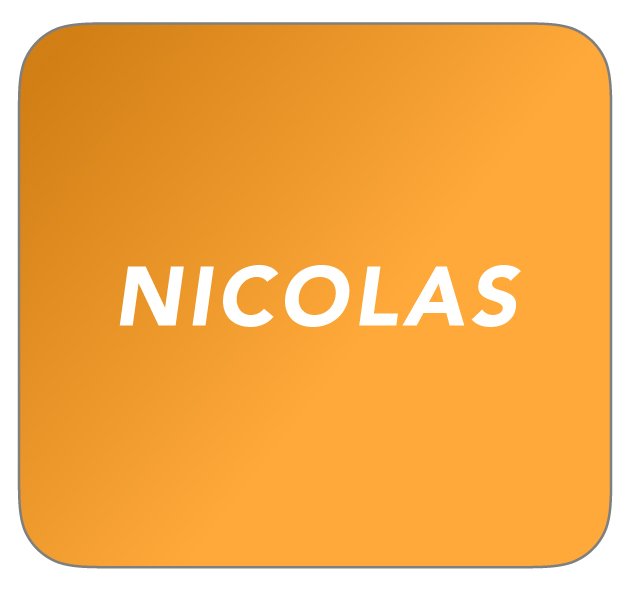
[EN] : Hello @rimicane! I won't make too much proposal as Vincent already did it. He gave you lots of directions. Nevertheless, I have to correct one thing : it is not an architecture photo but an urban photo. An urban photo is like a wide landscape and gives a context to the picture. At the opposite, an architecture photo is more restricted to an aspect that becomes the main focus. Architecture photographers are among the purist : a line is a line, a diagonal is a diagonal. They use the colors to make it visible. And play with color contrast to highlight their lines or diagonals. Here, it is not your case as it is not minimalist and by so your picture is a an urban photography.
In this perspective, your photo is correct. The cloudy sky brings a lot. On the other side, the buildings have colors and I don't understand why you add more colors. You 'd better focus on the sky render to get an opposition with the colors of the buildings.
A last point : I guess you were closed from the buildings. As a consequence, you have really strong perspectives and this also gave you a none interesting part : we have three buildings following a diagonal and then our eyes see a messy part (on the right side).
[FR] : Bonjour @rimicane. je ne ferai pas de proposition graphique car je pense que Vincent t’as donné suffisamment de piste. Je vais déjà apporter une précision. Il s’agit d’un paysage urbain et non d’une photographie d’architecture. Un paysage urbain comme un paysage est assez large et laisse de la place au contexte. A contrario une photo d’architecture peu être plus restrictive et se refermer sur l’élément à mettre en avant. De plus les photographes d’architecture sont très très très puristes. Une ligne est une ligne, une diagonale est une diagonale. Ils jouent bien sûr avec les couleurs mais il faut que cela soit nettement visible. Que chaque couleur tranche avec la suivante. Une photographie d’architecture est très graphique voire minimaliste. Ce qui n’est pas le cas de la tienne qui pour moi s’apparente donc plus à un paysage urbain.
Ta photographie dans ce cadre là est correcte. Le ciel est chargé ce qui apporte un plus. Par contre les immeubles sont colorés donc je ne comprend pas l’intérêt d’avoir rajouté artificiellement de la couleur. Un ciel plutôt noir/gris en opposition avec tes immeubles colorés aurait eu plus d’impact.
Un dernier point qui est sans doute du à la focale que tu as utilisé. Tu as pris ce paysage de très près ce qui du coup donne des perspectives très fortes. Et en plus cela t’as obligé à intégrer dans ton image quelque chose qui finalement n’apporte rien. On a ces 3 bâtiments du plus petit au plus grand avec un effet d’escalier puis une zone très brouillonne.
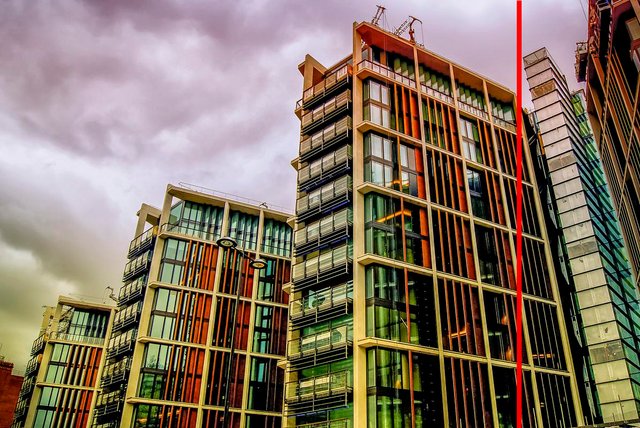
[FR] : Dans ce cas là et évidemment si l’on peut l’idéal est de s’éloigner du sujet. D’abord car l’on va récupérer des verticales plus verticales et surtout on va pouvoir exclure du champ les éléments perturbateurs. Sur cette image pour t’en sortir le plus simple est sans doute de faire un recadrage en carré. Lorsqu’on débute on passe beaucoup de temps à recadrer sur l’ordinateur car il y a plein de choses qu’on ne voit pas à la prise de vue. Avec le temps, la technique et la feignantise on apprend à faire bien ou le mieux qu’on peut dès la prise de vue afin de limiter le temps passé devant l’ordinateur. Voici un essai rapide en carré avec avec ta colorimétrie mais je pense qu’il faudrait que tu essayes avec un des exemples fournis par Vincent.
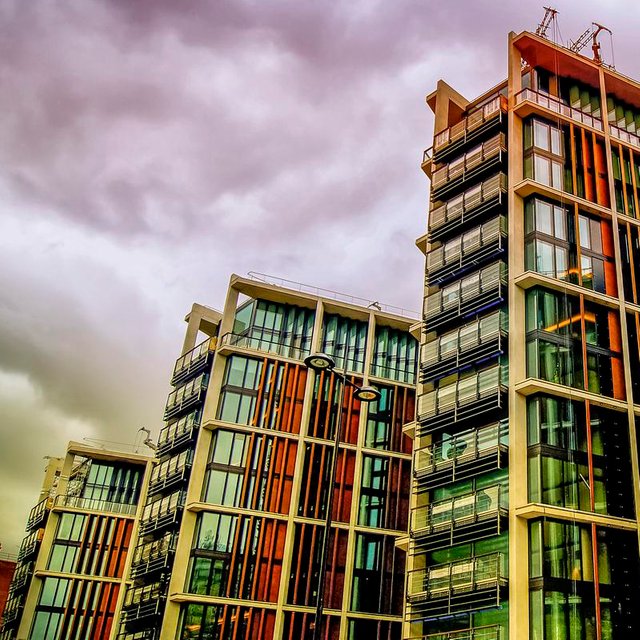
[FR] : Je te conseillerai donc d’y retourner, de tourner autour de ton sujet, de t’en approcher, de t’en éloigner et de voir les différences que tu vas obtenir. Et ne t’inquiètes pas lorsqu’on débute en photographie et que l’on veut évoluer, on passe 2 ans facilement à appréhender la technique avant de pouvoir s’en affranchir.

NOW YOUR TURN TO COMMENT ! / MAINTENANT A VOUS DE COMMENTER!

COMING NEXT / A SUIVRE : @intrepidphotos

Want to submit your pic? Use #photoreview in your post

2 professionnal photographers and photo curators
>>> Join our Discord Channel <<<

Thank you @photoreview for the given advice! The gradient tool will be forgotten, haha, the definition of the architectural photography - checked! I knew about the building on the right-hand side but was afraid to go over the original ratio, but with your suggestion, I will crop them accordingly from now on! Sometimes it is really hard to get the right angle and you can only get better with a lot of practice! Practice makes perfect! :)
Hi @Rimicane don't hesitate to crop and try different things on your computer. After years you can do it during the session and not at home :)
I will try! It get's a bit complicated with some images to distinguish if something belongs to the frame. With this one - sure, with some objects in front of the subject - sure, but there is also a personal preference factor! So I will really spend some time on this one! :) Thank you!
These buildings are very graphic @rimicane, there are many different and interesting compositions to do in this place. Moreover I think that with the very good advice of @photoreview you can only amaze us the next time :) !
Well, I hope I do with some images ;) Need to think like a photographer next time :)
Exactly Maeva. These subjects are really a good subject because they are statics and always in the same place. A very good thing to go back :)
Congratulations @photoreview! You have completed some achievement on Steemit and have been rewarded with new badge(s) :
Click on any badge to view your own Board of Honor on SteemitBoard.
For more information about SteemitBoard, click here
If you no longer want to receive notifications, reply to this comment with the word
STOP